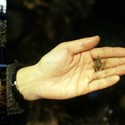Reiko Goto
Washington Art Commission, Art in Public Places
Artwork for the Edmonds Community College, Lynnwood, WA, 1991
A permanent project for the Edmond Community College, project funding and management by the Washington Arts Commissionn art in public place program. Nestled on a hillside, amongst firs and aspen the project appears to be an old timber framed structure (6′ wide x 10′ deep x 8′ tall) with a stone foundation. The title is a translation of a Japanese Haiku poem by Ikkyu. The project was intended to help support what was left of once prolific tree frog community that had been compromised by aggressive local development. Inside of the timber framed house, the artist crated a small pond with native aquatic plants. The sculpture was designed to house sapling of indigenous trees as well as a habitat for tree frogs in the area.
Review
New sculpture on campus dedicated
By Carol Ann Lindley
The Review An ASEdCC Publication, Tuesday, Nov.26,1991
Have you noticed the 6’x10’x8′ cedar structure in the northwest corner of the heating plant plaza at the west end of the pedestrian bridge of Mountlake Terrace Hall? Have you wondered what it is?
It is a sculpture – environmental art created by artist, Reiko Goto, based on a Japanese Haiku poem by Ikkyu.
The artist statement says, “The structure was designed to house saplings of indigenous trees as well as terrarium for the tree frogs abundant in the area, thus providing a link or bridge between the human visitors and animal inhabitants,”
The name of the sculpture is, “No walls, no roof, no anything my house, doesn’t get wet, doesn’t get blown down.”
It may not seem like a sculpture according to traditional concepts, but as President Tom Nielson mentioned during the dedication Friday, November 14, “Art takes many forms.”
Ravens and crows are the natural enemy of tree frogs, and EdCC Office Administration Instructor Jil Siano had noticed an unusually high amount of crows hovering over the area above the structure the day prior to the dedication. The two frogs which had been put in the pond within the structure the previous day were not visible during the dedication. Once there is more greenery within and around the structure, there will be more protection for the frog.
Reiko’s idea was to create an atmosphere which if maintained and further development (by planting more plants for protection) could re0create a home for the tree frog and cause their population to flourish again. When she had visited the college in 1989 to start this project she had noticed an abundance of tree frogs, which seem to have diminished since the recent development of our golf course.
The sculpture was completed in June of 1991 at a cost of $20,000. The original proposal for the piece had changed three times during the course of its creation, due to safety and vandalism hazard concerns.
An advisory board was set up for this project, including Sharon Cavender, Stan Linder of the Horticulture Department, Eileen Soldwedel, Don Bloom, Margaret Hayes, and Steve Hanson.
Whenever a new building is built on State property one half of percent of the applicable building costs (about 80% of the actual construction costs) are appropriated to the Washington State Arts Commission for public art. The Commission then selects an artist based on a proposal of a theme (not on a specific piece of art.)
The sculpture was funded by the Percent for Art Program through the Arts Commission with the funds appropriated from the construction of Alderwood Hall.
Funded by the state, it is part of the State’s public art collection.
